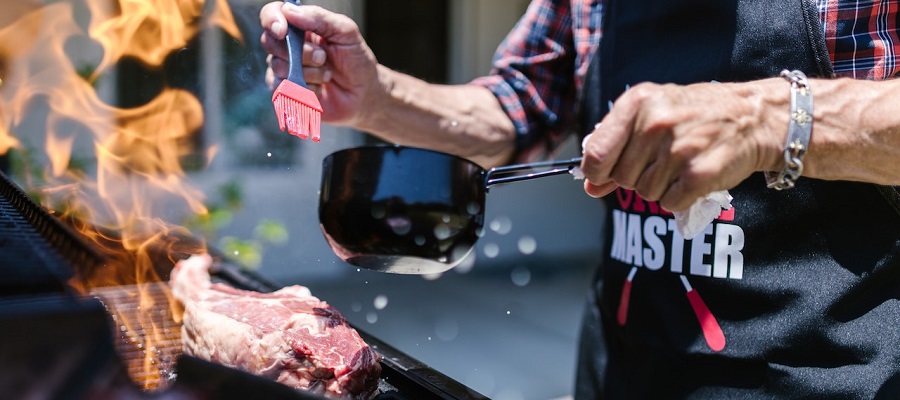Steak is a type of meat that is typically cut from the muscle of a cow, sheep, or other animal. It is typically cooked by grilling, pan-frying, or broiling and is often served as a main course.
There are many different types of steak, including ribeye, sirloin, filet mignon, and T-bone, which are named after the specific part of the animal from which they are cut. The tenderness, flavor, and price of different types of steak can vary widely depending on the specific cut and the quality of the meat.
Steak is a good source of protein, iron, and other nutrients, but it is also high in saturated fat and cholesterol. It's important to consume steak in moderation and to choose lean cuts, such as sirloin or filet mignon, to reduce the intake of saturated fat. It's also a good idea to pair steak with vegetables and whole grains to create a balanced meal.
When preparing steak, it's important to choose high-quality meat and to follow safe cooking practices to reduce the risk of foodborne illness. Steak should be cooked to a safe internal temperature to ensure that it is safe to eat. The recommended internal temperature for cooked steak is 145°F (63°C) for medium-rare and 160°F (71°C) for medium.
Degrees of cooking steak
There are several degrees of doneness that can be achieved when cooking steak, and the desired degree of doneness can depend on personal preference. Here are a few common degrees of doneness for steak and the corresponding internal temperature:
-
Rare: A rare steak is seared quickly on high heat and has a cool, red center. The internal temperature of a rare steak should be around 120-125°F (49-52°C).
-
Medium-rare: A medium-rare steak is seared on high heat and has a warm, pink center. The internal temperature of a medium-rare steak should be around 145°F (63°C).
-
Medium: A medium steak is cooked longer than a medium-rare steak and has a warm, pink center. The internal temperature of a medium steak should be around 160°F (71°C).
-
Medium-well: A medium-well steak is cooked longer than a medium steak and has a mostly pink center with a small amount of brown in the middle. The internal temperature of a medium-well steak should be around 165-170°F (74-77°C).
-
Well-done: A well-done steak is cooked until it is brown throughout and has a firm texture. The internal temperature of a well-done steak should be around 175-180°F (79-82°C).
It's important to use a meat thermometer to accurately gauge the internal temperature of the steak to ensure that it is cooked to the desired degree of doneness. Overcooking steak can result in a dry, tough texture, so it's a good idea to use a meat thermometer to avoid overcooking.
Side dishes that can be eaten alongside steaks
There are many side dishes that can be enjoyed alongside steaks, depending on personal preference and dietary needs. Here are a few examples of side dishes that can be served with steak:
-
Roasted or grilled vegetables: Roasted or grilled vegetables, such as asparagus, bell peppers, or zucchini, can provide a refreshing and healthy contrast to the richness of the steak.
-
Mashed or roasted potatoes: Mashed or roasted potatoes can be a comforting and satisfying side dish to pair with steak.
-
Salad: A salad made with a variety of vegetables and topped with a light dressing can provide a refreshing and light contrast to the steak.
-
Grilled or roasted fruit: Grilled or roasted fruit, such as peaches, plums, or pineapples, can provide a sweet and flavorful contrast to the steak.
-
Grilled or roasted corn: Grilled or roasted corn can provide a sweet and savory contrast to the steak.
-
Sauteed mushrooms: Sauteed mushrooms can provide a savory and rich contrast to the steak.
-
Baked beans: Baked beans can provide a hearty and flavorful contrast to the steak.
There are many other side dishes that can be enjoyed alongside steak, and it's a good idea to choose a variety of side dishes to create a balanced meal. It's also a good idea to consider any dietary needs or restrictions when selecting side dishes for a steak dinner.
Sauces can be eaten alongside steaks
There are many sauces that can be enjoyed alongside steaks, depending on personal preference and the flavor profile of the steak. Here are a few examples of sauces that can be served with steak:
-
Steak sauce: Steak sauce is a savory condiment that is typically made with a combination of ingredients such as tomatoes, vinegar, spices, and sometimes Worcestershire sauce. Steak sauce can provide a bold and flavorful contrast to the richness of the steak.
-
Chimichurri sauce: Chimichurri sauce is a bright and flavorful sauce made with a blend of herbs, garlic, and vinegar. It can provide a refreshing and tangy contrast to the steak.
-
Horseradish sauce: Horseradish sauce is a spicy and pungent condiment made with grated horseradish and vinegar. It can provide a bold and piquant contrast to the steak.
-
Blue cheese dressing: Blue cheese dressing is a creamy and tangy condiment made with blue cheese and mayonnaise. It can provide a bold and tangy contrast to the steak.
There are many other sauces that can be enjoyed with steak, and it's a good idea to choose a sauce that complements the flavor profile of the steak. It's also a good idea to consider any dietary needs or restrictions when selecting a sauce to accompany a steak dinner.


